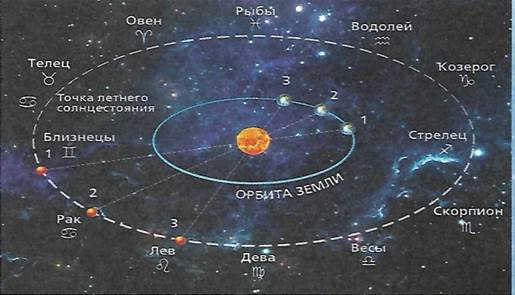When observing the trajectory of the planets over an extended period, it becomes apparent that the planets generally follow a westerly to easterly course, remaining close to the ecliptic and consistently within the zodiacal constellation belt. This planetary movement, akin to the motion of the Sun and Moon amidst the stars, is referred to as direct motion.
During the course of each planet’s motion, there are intermittent pauses known as stations, after which the planet begins to travel in the opposite direction, from east to west. This backward, or retrograde, motion persists for a period of several weeks or months, followed by a new station (a new state), after which the planet resumes its direct eastward trajectory. As a result, the observable path of the planets in the sky takes on a loop-like or zigzag pattern.
Mercury has a sideways motion arc of approximately 13 0 , Mars has one of around 15 0 , and Jupiter’s is slightly over 10 0 .
Curved segments of the planets’ visible paths can be found in various zodiacal constellations.
Mars completes a full circuit around the belt of zodiacal constellations in 687 days, Jupiter does so in 12 years, and Saturn takes 29.5 years.

On occasion, these three planets come close to the Sun and become invisible, before gradually moving away to the west and forming another loop in the sky opposite the Sun. Depending on their location in relation to the Sun, these planets can be seen at various times during the night, including throughout the entire dark period.
Mercury and Venus are constantly close to the Sun, orbiting it in alternating directions to the west and east, but never straying more than 28 degrees (Mercury) and 48 degrees (Venus). Because of their proximity to the Sun, these two planets can only be seen in the eastern part of the sky in the morning, before sunrise, or in the western part in the evening, shortly after sunset. As a result, the apparent movement of Mercury and Venus is significantly different from the apparent paths of Mars, Jupiter, and Saturn. The Sun and Moon move in large circles in a straight direction against the backdrop of the stars.
The Sun’s movement among the stars is not uniform.
In addition to the familiar daily movement of the Sun in the sky that we have observed since childhood, there is also an annual movement of our star on the celestial sphere along a specific line known as the ecliptic.
The Ecliptic is the representation of the Earth’s orbit on the celestial sphere. It traverses through twelve zodiacal constellations: during the month of May, the Sun moves through the constellation Taurus, in June it moves through Gemini, in August it moves through Leo, and in November it moves through Scorpio, and so on.
If you observe the Sun’s movement along the Ecliptic throughout the year, you will notice its irregularity. For instance, on March 21, which marks the vernal equinox, the Sun lies on the Ecliptic at the point of Aries, also known as the vernal equinox point. As it continues along the Ecliptic, on June 22, the Sun reaches the point of the summer solstice, which is Cancer. On this day, the duration of daylight in the Northern Hemisphere is at its maximum.
Continuing its journey, after covering an arc of 180 degrees on the Ecliptic, on September 22, the Sun crosses the point of the autumnal equinox, which is Libra.
On December 22, the Sun reaches the winter solstice point in Capricorn; the length of this day is at its minimum.
After completing a full orbit on the ecliptic, the Sun finishes its annual journey through the zodiacal constellations at the vernal equinox.
Measurements of the Sun’s apparent angular diameter throughout the year have revealed that it is largest in early January, measuring approximately 32 0 5′. In contrast, it is smallest at the beginning of July, measuring 31 0 5′.
As the Sun’s motion along the ecliptic mirrors the Earth’s motion around the Sun, this indicates that the Sun is closer to us during winter than in summer. However, the change in distance to the Sun during the year is so slight that it does not impact the Earth’s seasons.
The Moon’s path among the stars is similar to that of the Sun, but much more intricate.
By observing the planetary movement over an extended period, it becomes apparent that the planets primarily move in an eastward direction, staying close to the ecliptic and consistently within the zodiacal constellations. This planetary motion, akin to the Sun and Moon’s motion amongst the stars, is referred to as direct motion.
During the course of their movement, each planet periodically experiences pauses known as stations, after which the planet begins to move amongst the stars in the opposite direction, namely westward. This backward motion, or retrograde motion, lasts for a few weeks or months before another station (a new state) occurs, and the planet resumes its forward motion to the east. Thus, the apparent path of the planets in the sky takes on a loop-like or zigzag shape.
The backward motion of Mercury is approximately 130 degrees, Mars is about 150 degrees, and Jupiter is slightly over 100 degrees.
Sections of the planets’ visible path can be found in various zodiacal constellations in a loop-shaped pattern.
Mars completes a full orbit around the belt of zodiacal constellations in 687 days, Jupiter in 12 years, and Saturn in 29.5 years.

These three celestial bodies go through a regular cycle of being close to the Sun and becoming invisible, then slowly moving away from it towards the western sky, forming a loop on the opposite side of the Sun. Their visibility during the dark hours of the day varies depending on their position in relation to the Sun, with the possibility of being seen throughout the night.
Mercury and Venus are constantly in close proximity to the Sun, moving away from it in alternating directions to the west and east, but never more than 28° (Mercury) and 48° (Venus). Due to their close proximity to the Sun, these two planets can only be seen in the eastern part of the sky in the morning, before sunrise, or in the western part in the evenings, shortly after sunset. Therefore, the apparent motion of Mercury and Venus differs significantly from the apparent path of Mars, Jupiter, and Saturn. The Sun and Moon move in large circles against the backdrop of the stars, always in a straight direction.
The Sun’s movement among the stars is not uniform.
In addition to the familiar daily movement of the Sun in the sky that we have observed since childhood, there is also an annual movement of our Sun on the celestial sphere along a specific line known as the ecliptic.
The Ecliptic is the representation of the Earth’s orbit projected onto the celestial sphere. This path intersects with 12 zodiac constellations: Taurus in May, Gemini in June, Leo in August, Scorpio in November, and so on.
If you observe the Sun’s movement along the Ecliptic throughout the year, you will notice its unevenness. For instance, on March 21, during the vernal equinox, the Sun aligns with the Aries point on the Ecliptic. As it continues along this path, on June 22, the Sun reaches the point of the summer solstice – Cancer. On this day, the Northern Hemisphere experiences the longest daylight hours.
After traversing an arc of 180 degrees on the Ecliptic, on September 22, the Sun crosses the point of the autumnal equinox – Libra.
On December 22nd, the Sun reaches its lowest point in the zodiac sign Capricorn, marking the winter solstice. The length of this day is at its minimum.
After completing a full orbit on the ecliptic, the Sun finishes its annual journey through the zodiac constellations at the spring equinox.
Measurements of the apparent angular diameter of the Sun throughout the year reveal that it reaches its maximum size, about 32 0 5′, in early January. In contrast, it reaches its smallest size, about 31 0 5′, at the beginning of July.
Since the Sun’s movement along the ecliptic mirrors the Earth’s movement around the Sun, this means that in winter, the Sun is closer to us than in summer. However, the change in distance to the Sun over the course of the year is so minimal that it has no impact on the changing seasons on Earth.
It is common knowledge today that all the planets in the solar system orbit around the Sun. However, it took humanity many centuries to discover this fact. For a considerable period of time, individuals held the belief that the Earth was the center of the universe and that the Sun revolved around it.
Various Types of Planetary Motion
Tycho Brahe, an astronomer who was influenced by Copernicus, conducted his own observations of celestial bodies on his private island. Using large bronze circles, he recorded his findings regarding the movement of these bodies. These records eventually made their way to mathematician Johannes Kepler, who formulated three laws to describe planetary motion.
The first law, according to Kepler, states that planets move in circular orbits. However, Kepler’s calculations did not completely align with actual observations, leading him to propose that planetary orbits are actually elliptical in shape. Each elliptical orbit possesses two focal points, also known as given points. Therefore, Kepler’s first law can be summarized as follows:
The 2nd principle of planetary motion is about drawing a radius vector from the Sun to the planet, with the celestial luminary at one of the foci of the orbit. This radius vector will cover equal areas on the plane as the planet moves around the Sun.
The 3rd principle of planetary motion states that all planet orbits have a perihelion (the point closest to the Sun) and an aphelion (the point farthest from the Sun). The major axis of the orbit is the segment between these two points. Dividing this segment in half gives the major semi-axis, which is important in astronomy.
This principle is utilized to determine the duration of a year, the time it takes for a planet to complete one orbit around the Sun (T). To obtain this value, it is only necessary to know the distance between the Sun and the planet (a).
In contemporary astronomy, there exist various forms of planetary motion:
Prior to delving into a more detailed examination of each type of planetary motion within the solar system, it is important to note that all planets are conventionally classified as either upper or lower, or inner and outer. The lower (inner) category includes Mercury and Venus, while the upper (outer) category encompasses all others (Mars, Jupiter, Saturn, Uranus, Neptune). This classification is based on their relationship to Earth’s orbit.
The lower planets, such as the Moon, undergo a phase change during their visible movement. As they move, Mercury and Venus periodically find themselves positioned between the Earth and the Sun or behind the Sun. In these instances, the planets are not visible as they are obscured by the Sun’s rays. The period when the inner planet is closest to the Earth is known as the lower conjunction, while the upper conjunction refers to the period of maximum distance between the planet and Earth. The appearance of the Sun-lit hemisphere of the inner planet will vary depending on its position in relation to the Earth. During the lower conjunction, the planet faces the Earth with its unlit side, rendering it invisible to observers. However, as it tilts slightly away from this position, it begins to resemble a crescent shape. The size of the visible crescent increases as the angular distance between the planet and the Sun grows. When the angle between the directions to the Earth and the Sun reaches 90 degrees, the observer can see exactly half of the illuminated side of the inner planet. At the upper conjunction, the fully illuminated side of the planet is turned away from the Earth, but remains hidden due to the Sun’s rays. This is a unique characteristic of the lower planets, as the illuminated side of the upper planets is always visible to observers on Earth. If an observer were to move to a point beyond Saturn’s orbit, they would be able to observe the Earth, Mars, Jupiter, and Saturn undergoing phase changes. From this vantage point, these planets would appear partially visible and partially hidden. It is not possible to see the phases of the planets from Earth using binoculars; a telescope or other equipment would be required.
Backward, forward, and cyclic movement of the planets
The forward motion of the planets refers to the celestial bodies’ movement from the west to the east, aligning with the Sun’s direction.
The backward, also known as retrograde, motion of the planets involves the movement of the celestial orbs in relation to the stars in the sky from the east to the west. In simpler terms, this direction is contrary to the Sun and Moon’s motion.
Ecliptic: The Sun’s Path in the Sky
Ancient astronomers observed that the Sun’s position in the sky varies throughout the year. At noon, its height changes, and if you look at the horizon from the south at midnight during different seasons, you can see different constellations. For example, in summer, certain constellations are visible while they are not in winter, and vice versa. These observations led to the discovery of the Sun’s annual motion relative to the stars, which is known as the ecliptic.
It is common knowledge that the Sun’s movement is contingent upon certain conditions. The apparent movement of the star is linked to the Earth’s orbit around the Sun. The Earth completes a full rotation on its axis, known as a day, in 23 hours, 56 minutes, and 4 seconds. Consequently, the Sun moves across the sky by 1° each day. The duration in which it completes a full circle on the celestial sphere is known as a year, which consists of 365 days and 6 hours. Every fourth year is designated as a leap year, as additional days are accumulated during this period. Therefore, in a leap year, there is one extra day, making the total number of days 366.
Astrological Star Groups
As the Earth completes its journey around the Sun, it passes through a series of star groups known as zodiacal constellations. These constellations, which lie along the path of the Sun’s apparent motion called the ecliptic, have been recognized since ancient times.
Traditionally, there were 12 zodiacal constellations, but modern astronomy has identified a 13th constellation that lies on the ecliptic. Each of these constellations has been given a name, often based on their resemblance to certain objects, animals, or figures. Today, these constellations are well-known and include:
- Aries.
- Taurus.
- Gemini.
- Cancer.
- Leo.
- Virgo.
- Libra.
- Scorpio.
- Serpens.
- Ophiuchus.
- Sagittarius.
- Capricorn.
- Aquarius.
- Pisces.
If you initiate the Sun’s movement report from Aries (April 19 – May 3), in exactly one year, the star will be in the same constellation once again. The Moon will traverse all zodiacal constellations in a shorter period, only a month, as it requires just 27 days for a complete revolution around the Earth. The constellations and planets will move at different speeds, which depend on their distance from the Earth and the Sun. The point of the vernal equinox – March 20 – serves as the starting point for the zodiacal constellations.
Each zodiacal constellation contains a multitude of brilliant stars. These stars played a crucial role in dividing the sky into distinct sections, with each constellation acquiring its own set of boundaries. Among the many luminous stars, a few notable ones include Pollux, Alchena, and Castor in Gemini, Sargas and Antares in Scorpio, and Nunki and Kaus Australis in Sagittarius. Leo boasts stars like Algieba and others.
It is worth noting that the modern boundaries of constellations were officially established in 1928 by the International Astronomical Union.
The ancient ones revered and held sacred the constellation that we know as Taurus. It is a prominent constellation that can be easily observed throughout the country, even without any instruments. Taurus is located in the Northern Hemisphere and offers a stunning display of 216 stars. The ideal time to observe Taurus is from November to January. Among the notable bright stars in Taurus are Aldebaran, Nat, and Alcyone. Aldebaran, in particular, stands out as the 17th largest star in the sky.
Another constellation that graces the Northern Hemisphere is Gemini. It is distinguished by two relatively bright stars, Castor and Pollux, which are positioned in close proximity to each other. These stars symbolize the heads of twin brothers. The feet of the twins are positioned on the Milky Way, pointing towards the southwest. Gemini is best observed during the months of December and January. With the naked eye, you can admire a total of 70 stars in Gemini, making it the 30th largest constellation in terms of area.
The constellation Cancer, which is located in the Northern Hemisphere, is ranked 31st in terms of its area. It is considered one of the oldest and least notable constellations. The best time to observe Cancer is during the months of January and February. The history of this zodiacal constellation is quite fascinating. During a battle between Heracles and the Lernaeus Hydra, Heracles was also attacked by the sea creature Cancer. Despite the attack, Heracles managed to defeat the villain. However, the goddess Hera, who had a dislike for Heracles, decided to immortalize Cancer by placing it in the night sky. Without the need for any instruments, around 60 stars of Cancer can be seen on a clear night without any interference. Two of the brightest stars in the constellation are Altarf and Akubens.
Ranked 12th in terms of area, Leo is a constellation of the Northern Hemisphere. With the naked eye, you can spot up to 70 stars in this constellation. The prime months for observation are from February to March. The body of the Lion is depicted by a trapezoid shape formed by 4 luminous stars. The head of the Lion is represented by an arc of stars. The brightest star in Leo is Regulus, known for its blue-white color.
Libra is a constellation situated in the Southern Hemisphere and is ranked as the 29th largest in terms of area. It is widely recognized as one of the most easily identifiable constellations in the night sky. With the naked eye, one can spot a total of 83 stars within its boundaries. The optimal time for observing Libra is during the months of April and May. However, the constellation is fully visible only in the central and southern regions of Russia. The origin story of Libra is particularly fascinating. According to legend, Astraea, the daughter of Zeus and the goddess Themis, brought this celestial object to Earth. She would use her blindfold and scales to impartially assess human life, identifying those who were dishonest, deceptive, or in violation of the law. In honor of his daughter, Zeus decided to immortalize these scales as a symbol of remembrance.
The constellation can be found in the Southern Hemisphere along the Milky Way and showcases a distinguishable pattern representing Scorpius. The most striking feature of this zodiacal constellation is the red supergiant, Antares. This star’s diameter and luminosity are hundreds of times greater than that of the Sun. Additionally, Scorpius contains several star systems, and it is possible to observe 100 stars with the naked eye. Late summer is the optimal time for observing Scorpius. It is the 33rd largest star based on its area.
Scorpius is positioned in the Southern Hemisphere and is the 11th largest constellation in terms of area. It is characterized by a prominent cluster of stars, with 100 visible to the naked eye. This zodiacal constellation received its name in ancient times. The image of the Serpent depicts Asclepius, the healer endowed with the ability to cure people. Notable bright stars within Scorpius include Ras Alhage and Sabic.
Located in the Southern Hemisphere, this constellation holds the 15th position in terms of area. There are 115 stars that can be seen with the naked eye. The primary stars of Sagittarius include Kaus Australis, Nunki, and Zeta Ascella. In southern Russia, this constellation can be observed well, particularly during the months of July and August.
Occupying the 40th position in terms of area, this constellation is also located in the Southern Hemisphere. Only 50 stars of this constellation can be observed without the use of optical instruments. It is highly visible in the southern and central parts of Russia. The best months for observation are July through August. Capricorn is a fascinating creature that possesses a body resembling a goat with a fish tail. A noteworthy feature of Capricorn is the presence of the globular cluster M30.
Aquarius is a constellation that has a long and storied history. It is one of the oldest and largest constellations in the zodiac, and it is the 10th largest in terms of area. This celestial formation is home to a stunning array of 90 stars that can be easily spotted with the naked eye. Among the brightest stars in Aquarius are Sadalsuud and Sadalmelik, both of which shine brightly in the night sky. The best time to observe Aquarius is during the months of August and September, and the best viewing locations are in the central and southern parts of the country.
In Greek mythology, Aquarius is associated with several prominent figures, including Ganymede, Deucalion, and Kekrop. These characters are often depicted in artwork and stories related to Aquarius. Additionally, many ancient civilizations believed that Aquarius represented a divine being known as An. According to these beliefs, An was responsible for watering the earth with life-giving moisture, bringing fertility and abundance to the land.
Astrologers, in contrast to astronomers, recognize only 12 zodiac signs. They create horoscopes for each of these signs, which are widely used by people on a daily basis and throughout the year. The time boundaries of these astrological constellations are arbitrary and do not align with astronomical ones. Astrologers have divided the entire ecliptic circle into 30-degree segments, resulting in the 12 Zodiac signs that correspond to specific months of the year. However, the Serpentarius constellation is not included in this list. While astronomy states that the Sun is in the Scorpio constellation for only 7 days, astrology extends this period to one month.
1. How are the direct and sideways motion of the planets different?
The direct motion of the planets refers to their movement between the stars, typically from west to east.
In contrast, the sideways motion of the planets is characterized by a slowing down of their motion and a change in direction from east to west.
2. How is the looping motion of the planets explained in the heliocentric system?
The looping motion of the planets is explained by considering the heliocentric system, where we observe the planets’ motion from the perspective of the Earth orbiting the Sun. This perspective takes into account the varying radii of the planets’ orbits and their orbital velocities, resulting in their loop-shaped paths.
3. What do we mean by planetary configurations? Can you describe them?
Planetary configurations refer to the unique and specific arrangements of the planets, including the Earth and the Sun. These configurations can vary and are categorized into two groups: lower planets and upper planets.
The lower planets consist of Mercury and Venus, while the upper planets include Mars, Jupiter, Saturn, Uranus, and Neptune.
4. Explain the synodic and sideric periods of planetary rotation. How do they differ?
The synodic period refers to the time it takes for a planet to reach the same configuration in its orbit as seen from Earth. It is the interval between two consecutive planetary configurations of the same name.
On the other hand, the sideric (or stellar) period is the time it takes for a planet to complete one revolution around the Sun in its own orbit, relative to the stars.
So, the main difference between the synodic and sideric periods is that the synodic period is based on the relative positions of the planet and Earth, while the sideric period is based on the planet’s orbit relative to the stars.
5. What is the interval of time in which Jupiter’s oppositions recur?
Using the formula for synodic motion of the outer planets,
we can calculate the synodic period of Jupiter (S) by substituting Jupiter’s orbital period (T) = 12 years and Earth’s orbital period (T) = 1 year. This gives us a synodic period of S = 1.1 years, or 398 days.
The sideric and synodic periods will appear to last for 1 year when observed from Earth.

Motion is a fundamental characteristic of matter, with every object in the vast expanse of the Universe constantly in motion. Celestial bodies, including those within the celestial sphere, are no exception to this universal principle. In this discussion, we will explore the intriguing topic of the apparent motions exhibited by these celestial entities, providing a comprehensive overview suitable for an 11th grade report.
The Sun, Moon, and Stars in Motion
Since ancient times, people have been observing the sky and focusing their attention on the sun, the moon, and the stars.
Throughout the day, all of these celestial bodies move across the sky along circular trajectories, with Earth at the center. This concept led to the development of an ancient cosmological system, placing Earth at the center of the universe, with the sun, moon, and stars orbiting around it on the celestial sphere.

Fig. 1. Image showing the movement of stars around the Earth’s pole.
The Sun follows a path on the celestial sphere that is similar to the stars, but at a slightly faster pace and with slight deviations over time. This path, known as the ecliptic, is the route the Sun takes in relation to the stars. The Moon also moves in close proximity to the ecliptic.
The movement of celestial bodies
Figure 2. The visible path of a planet in the sky.
Understanding the movements of celestial objects
While it was relatively straightforward to explain the movements of the Sun, Moon, and stars – as they followed circular paths – understanding the motion of planets was much more challenging. Ptolemy, who developed the laws governing planetary motion, proposed that planets move in epicycles, which are small circles whose centers revolve around the Earth on the celestial sphere. Although this model of the universe was complex, it accurately accounted for the characteristics of planetary motion and remained in use for over a thousand years.
This alteration in the global system accurately depicted the observable movements of the celestial objects:
Figure 3. Explanation of the orbit of a planet in the heliocentric system.
In the same publication, Copernicus determined the distances between the Sun and the planets, as well as the durations of their orbits.
While Copernicus did not assert the heliocentric system as absolute truth, he did acknowledge that it greatly simplified calculations. Nonetheless, the introduction of the heliocentric system provided a significant boost to the advancement of astronomical understanding.
The Copernican heliocentric system was further developed and supported by I. Kepler in the early 17th century. Kepler’s laws not only clarified the paths of the planets by describing them as ellipses rather than circles, but also enabled the calculation of motion velocities at any point on the ellipse.
What did we grasp?
The celestial sphere witnesses the movement of the sun, moon, and stars along circular trajectories, with their centers positioned on the hypothetical axis of the world. The planets, however, traverse loop-shaped orbits. The comprehension of the planets’ looping motion was only made feasible through the acceptance of the heliocentric model of the universe.
1. The planetary motion in a loop
In your natural history course, you were introduced to the general structure of the solar system. Now, we will delve deeper into the structure of the Solar System and focus on analyzing the observed motion of the planets. Among the planets visible to the naked eye are Mercury, Venus, Mars, Jupiter, and Saturn.
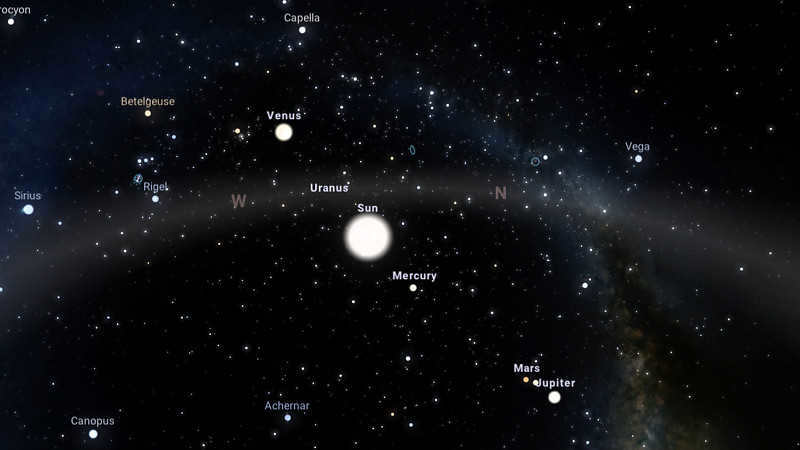
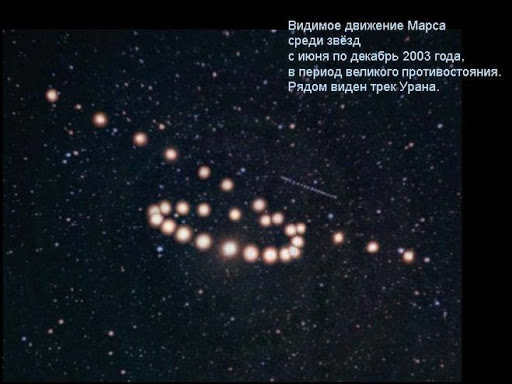
The movement of planets among the zodiac constellations was first explained by Nicolaus Copernicus in the early 16th century. This phenomenon occurs because the Earth and planets orbit the Sun at different speeds. In order to describe the changing equatorial coordinates of celestial bodies such as the Moon, Sun, and planets, the concept of the ecliptic is used. The ecliptic is the visible path that the center of the Sun’s disk follows on the celestial sphere over the course of a year. The Sun’s apparent motion along the ecliptic is a result of the Earth’s actual motion around the Sun (which was only proven in 1728 by James Bradley’s discovery of annual aberration, a deviation from the expected motion).
The trajectory of a celestial object is the path it follows in the universe. The speed at which planets orbit decreases as they get farther from the Sun. The orbits of all planets in our solar system are close to the ecliptic plane, but they deviate from it.
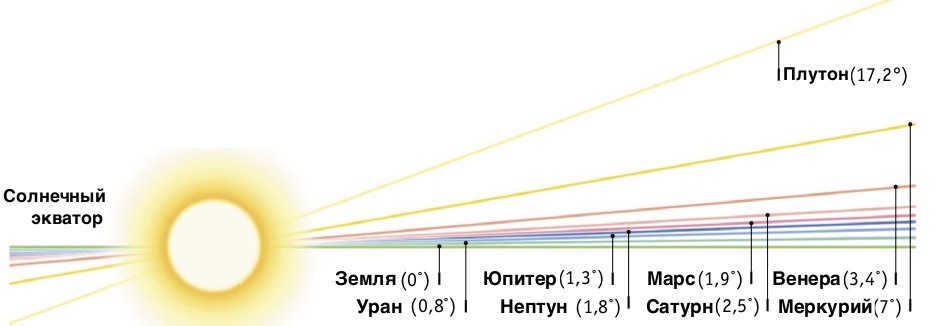
The celestial bodies in our solar system, including the planets, have interesting movement patterns. Most of the time, they move in a consistent direction from west to east, just like the Sun and the Moon. This is known as direct motion. However, at certain points in their orbit, each planet slows down, changes direction, and starts moving from east to west. This movement is referred to as retrograde motion. After a period of time, the planet stops again and resumes its direct motion. As a result, the visible path of each planet in the sky is a complex line with twists and turns. This path also changes from one cycle to another, as the planet returns to roughly the same position among the stars.
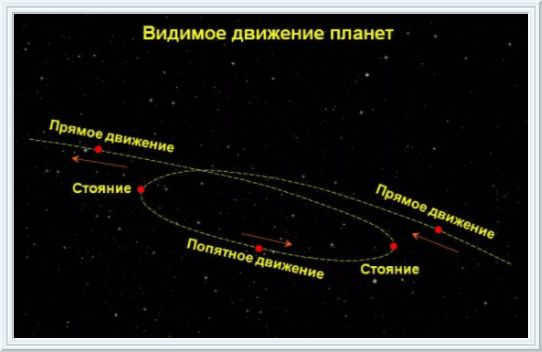
In terms of their orbit and visibility from Earth, planets are classified as inner planets (Mercury, Venus) and outer planets (Mars, Jupiter, Saturn, Uranus, Neptune). The outer planets always face the Earth with the side illuminated by the Sun. The inner planets undergo phases similar to the Moon. Planets that have orbits within the Earth’s orbit are referred to as lower planets, while those with orbits outside the Earth’s orbit are known as upper planets.
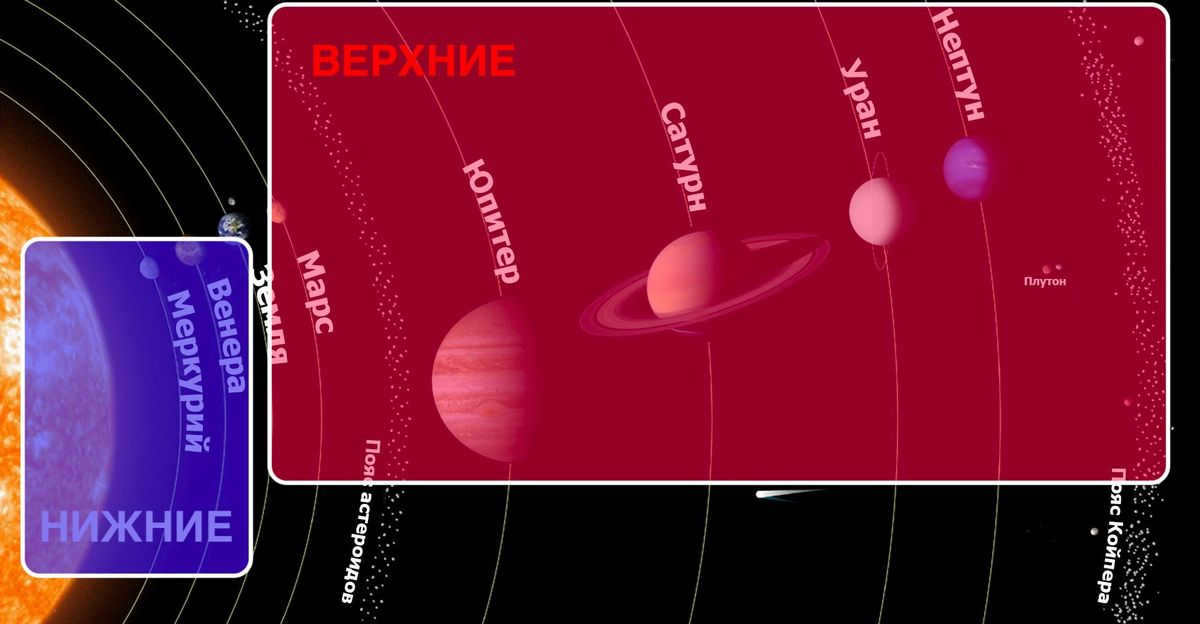
Due to the Earth’s orbit around the Sun, the paths of the outer planets appear to be not smooth and circular, as they actually are, but rather zigzag or loop-shaped. The planet rapidly moves forward, then comes to a halt, then moves backward, pauses again, and then leaps forward once more, continuing this pattern until it completes a full revolution across the entirety of the visible sky. This process then repeats on a new path.
For those of us who live in the post-Copernican era, this phenomenon is not at all surprising; in fact, it is expected. I will now provide an example that anyone can try themselves to help illustrate this type of movement. Take a pencil in your hand, hold it up to eye level, close one eye, and observe where the tip of the pencil appears to be on the wall.

Nicolaus Copernicus famously stated that the Earth, like the other planets, revolves around the Sun and also spins on its own axis. This revolutionary Copernican model provided a simple explanation for the planets’ circular paths. Each planet follows a unique orbit and thus has a distinct orbital period around the Sun, resulting in varying speeds for the planets’ movement both in relation to the Sun and to one another. The diagram below illustrates the trajectory of Mars as observed from Earth, with corresponding positions of Mars, Earth, and Mars’ path in the sky marked with matching symbols.
In the realm of astrology, this type of planetary motion is referred to as retrograde:
Therefore, the looping motion is determined by the relative position of the planets.
2. Planetary Configuration
Planetary configurations refer to specific arrangements of the planets, Earth, and the Sun. The configurations of the inner and outer planets differ due to variations in their visibility. The visibility of a planet is influenced by its position relative to the Sun, which provides illumination, and the Earth, from which we observe the planet.
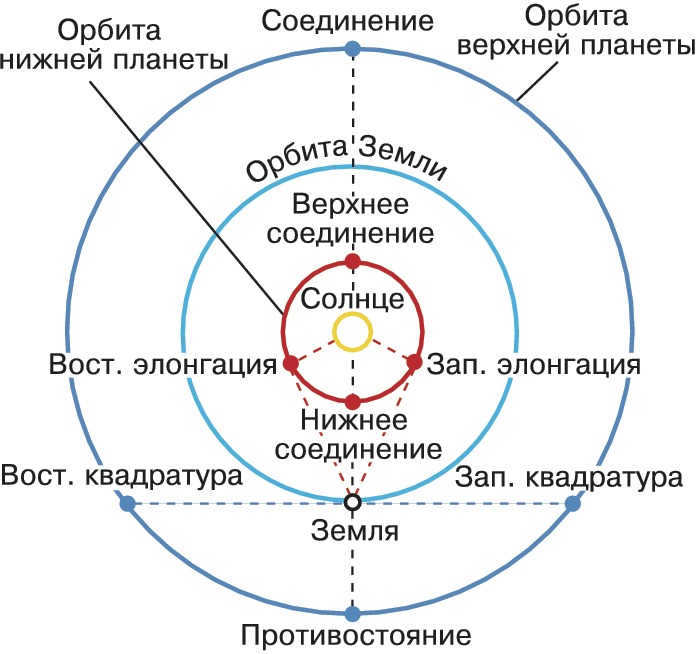
The visible path of the planets in the sky can be determined by looking at their conjuctions (lower and upper) and elongations (eastern and western).
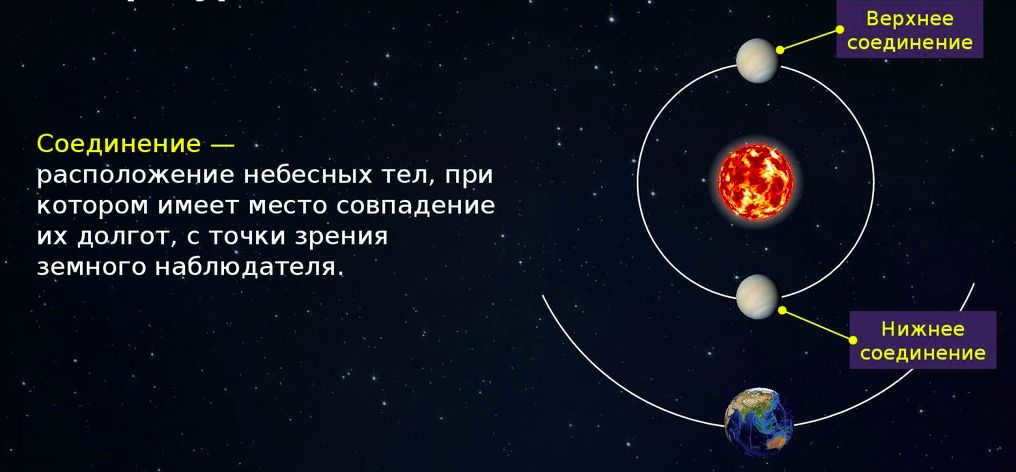
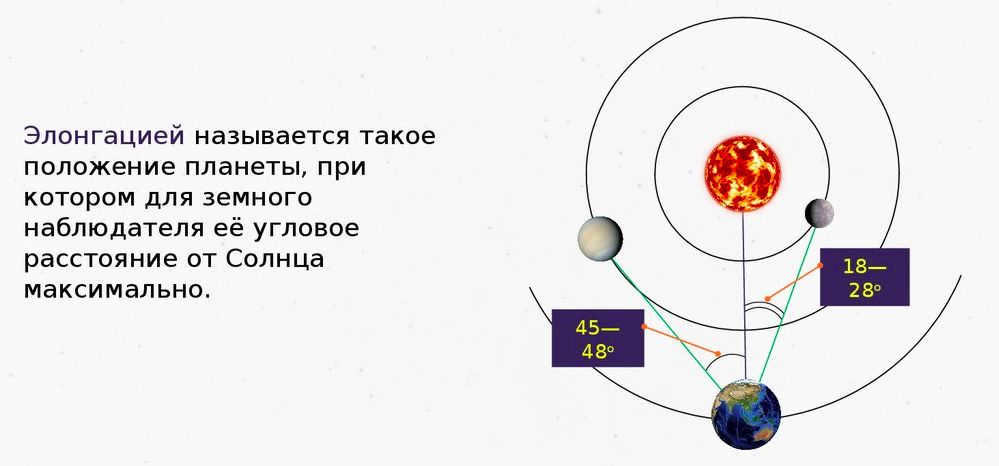

For the higher celestial bodies, there exist conjunction, opposition, and quadrature.
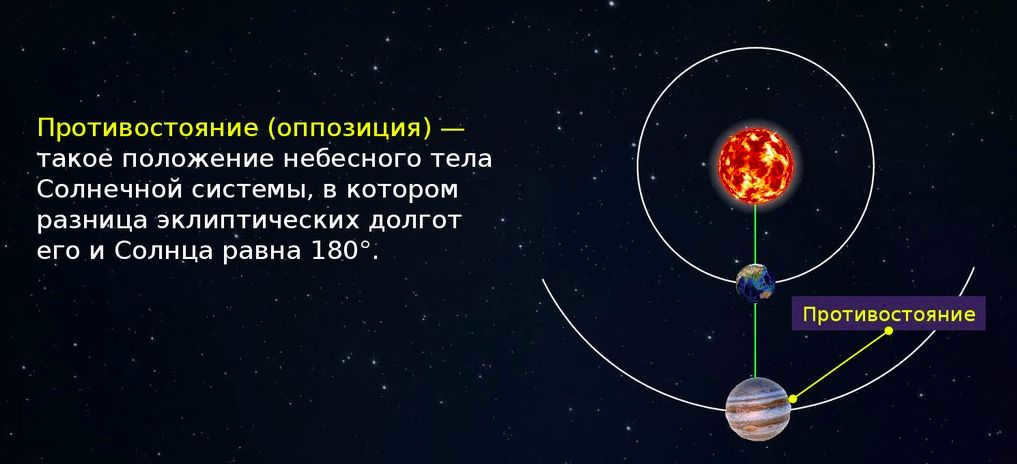
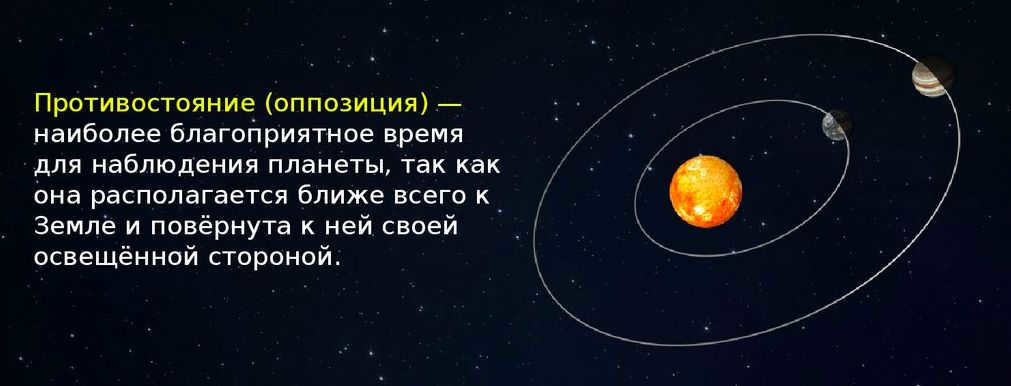
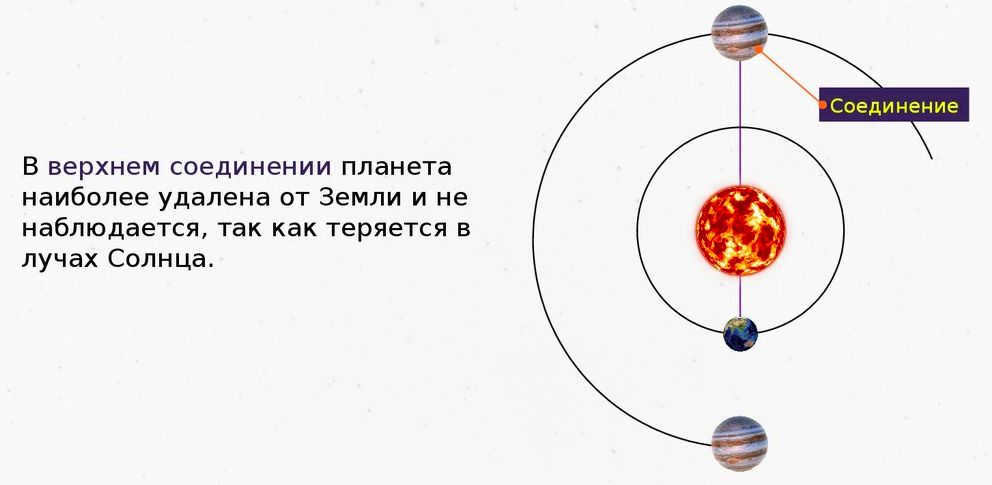
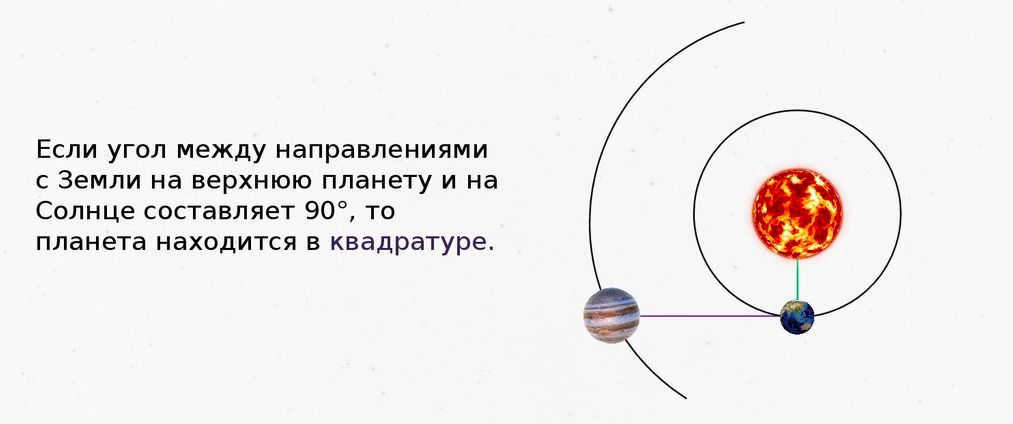

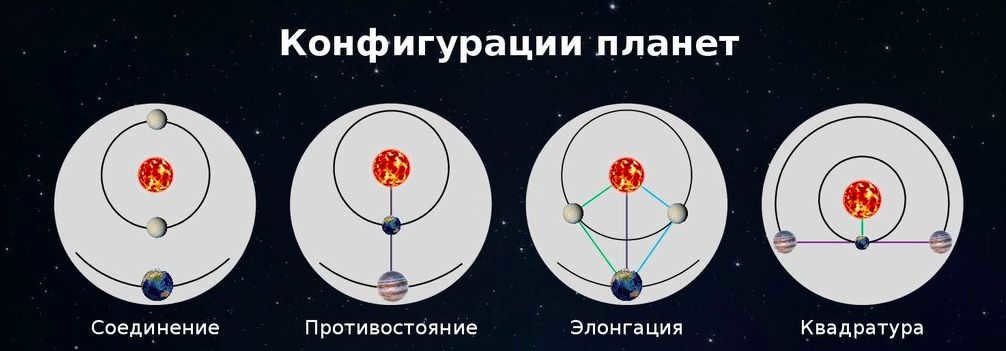

In ancient times, the synodic periods of the planets were computed under the assumption that all celestial bodies revolved around the Earth. However, we now understand that the Earth is not stationary but instead orbits the Sun along with the other planets. Therefore, the length of time it takes for a planet to complete one full revolution around the Sun in relation to the stars is known as the sideric (or stellar) period (derived from the Latin word sidus, meaning star; in the genitive case, sideris). To simplify matters, the sideric period is often referred to as a year. For instance, we have the Earth year, the Mercurian year, the Jupiterian year, and so forth.
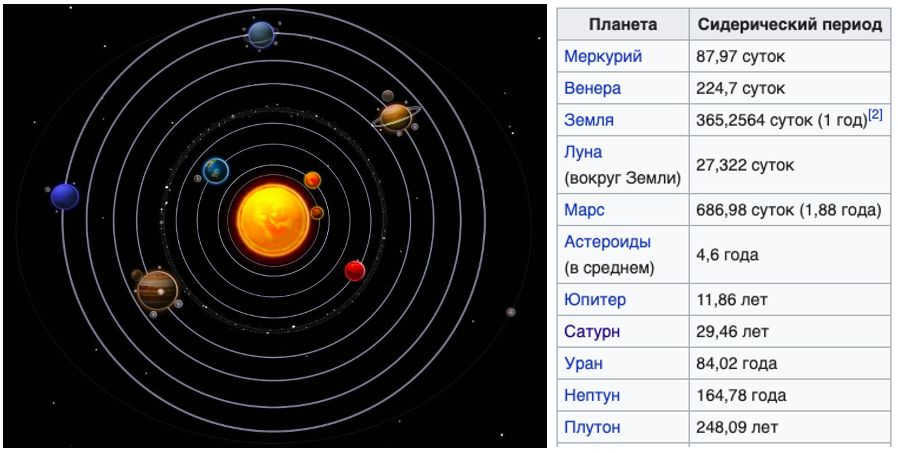
The duration of a planet’s orbit around the Sun, as observed from the moving Earth, cannot be accurately determined due to the Earth’s continuous motion in space. As a result, the planet’s projection against the backdrop of fixed stars is also displaced, making it possible that the planet may not reach or pass the point from which its motion was initially observed. However, there exists a correlation between the synodic (visible) and sideric (true) periods of the planets. Let us establish this relationship:
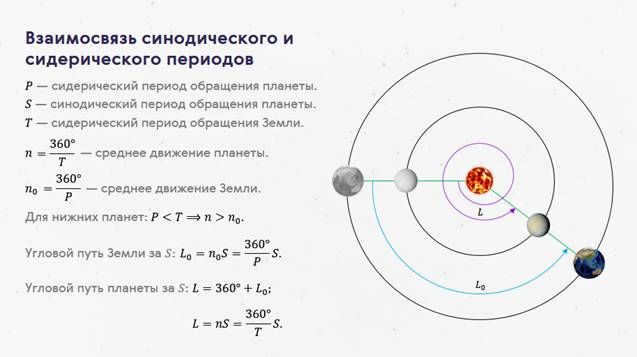
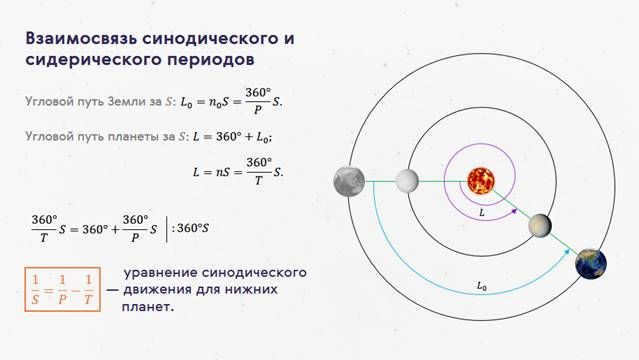
By using similar logic, we can derive the formula for the synodic motion of the planets located further away from the Sun. The key difference here is that their orbital period is longer compared to Earth’s. As a result, the Earth, being closer to the Sun, completes one revolution and catches up with the planet in question.
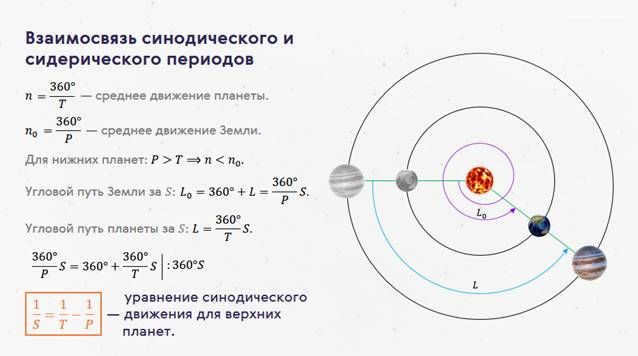
3. A day in astronomy and its various types
The length of a day on a planet is determined by its angular velocity of rotation. In the field of astronomy, there are multiple classifications of days based on different reference frames. If a distant star is chosen as the point of reference for rotation, then the duration of a day would be different compared to using the central star of the planetary system. On Earth, for example, there are two types of days: the average solar day which lasts for 24 hours, and the sidereal day which lasts for approximately 23 hours, 56 minutes, and 4 seconds. These two types of days are not equal to each other due to the Earth’s orbital motion around the Sun, causing the Sun to shift against the background of distant stars as observed from the Earth’s surface.
The sidereal day refers to the period of rotation of a celestial body around its own axis in an inertial reference frame. This frame of reference is usually associated with distant stars. In the case of Earth, it represents the time it takes for the Earth to complete one revolution on its axis with respect to distant stars. As shown in the diagram above, points 1-2 indicate stellar days.
A solar day, on the other hand, represents the time interval during which a celestial body completes one revolution around its axis relative to the center of the Sun. In the diagram above, points 1-3 represent solar days.
- Homepage /
- Education /
- Astronomy /
- Observing the apparent movements of planets relative to the fixed stars
Related Articles
Chapter 14: Ship basing and logistics
BAC-58 – Program for calculating altitudes and azimuths of luminaries. Description and Purchase
Tribute to the 4th Squadron of SSF Submarine Squadron
Leave a Comment
Top Stories
IDA-59M Isolating Breathing Apparatus
The IDA-59M Isolating Breathing Apparatus (Figure 9) is a self-contained, regenerative breathing apparatus with a closed breathing cycle. The device provides isolation for the organs of…
Technique for Artificial Ventilation and Closed-Chest Compression
When faced with different accidents where the individual is not breathing and there are no signs of heart contractions, it becomes imperative to initiate the process of artificial lung ventilation and closed-chest compression…
The Volkhov submarine fired a Kalibr cruise missile from a submerged position at a surface target located in the Sea of Japan.


The Bratsk, a multipurpose nuclear-powered submarine, has been deemed unsuitable for repair and will not undergo restoration

The Russian Navy will receive the improved Project 885M (code name “Yasen-M”) nuclear submarine “Kazan” in the autumn of 2020.

Commemorating 115 years of the Pacific Fleet’s submarine forces
Russia honored the 115th anniversary of the formation of the submarine forces in the Pacific Fleet. The initial fleet of submarines, known as “destroyers,” was established in Vladivostok in 1905.

The team of the Baltic Fleet’s underwater vessel Dmitrov has commenced executing combat training missions and honing their skills

Motion is an inherent characteristic of matter, and all objects within the vast expanse of the Universe experience some form of movement. The celestial bodies that populate the heavens are no exception to this fundamental principle. In this report, we will explore the visible movements of these celestial entities, focusing on the essential aspects that are relevant to the 11th-grade curriculum.
Observations of the heavens commenced in ancient times, with the initial focus of man being on the sun, moon, and stars.
During the daylight hours, all of these celestial bodies traverse the sky along circular paths, with the Earth positioned at the center. This fact enabled the development of an ancient cosmology, with the Earth occupying the central position in the Universe and the sun, moon, and stars orbiting around it on the celestial sphere.

Figure 1. A photo capturing the visible trajectory of stars around the Earth’s pole.
The Sun follows a similar circular path around the celestial sphere, but at a slightly faster pace compared to the stars. Over time, its position shifts in relation to the stars. This trajectory followed by the Sun among the stars is known as the ecliptic. The Moon also moves in proximity to the ecliptic.
The movement of celestial bodies
Figure 2. The apparent trajectory of a planet in the sky.
Explanation of the movements of celestial objects
If the movements of the Sun, Moon, and stars were easily explained – they followed circular paths – then the complex, looping movements of the planets posed a greater challenge. Ptolemy, in his establishment of the laws governing planetary motion, proposed that the planets move in epicycles – that is, in small circles whose centers revolve around the Earth on the celestial sphere. This model of the universe was unwieldy, but it effectively described the characteristics of planetary motion and endured for over a millennium.
This alteration in the world system effectively explained the observable movements of the heavenly bodies:
Figure 3. Explanation of the orbit of a planet in the heliocentric model.
In the same publication, Copernicus computed the distances between the Sun and the planets, as well as their orbital periods.
In his study, Copernicus did not assert the truth of the heliocentric model. He simply observed that this model significantly simplified calculations. Nonetheless, the introduction of the heliocentric model provided a significant boost to the advancement of astronomical understanding.
The Copernican heliocentric model was further developed and substantiated by I. Kepler in the early 17th century. Kepler’s laws not only clarified the paths of the planets by describing them as ellipses instead of circles, but also enabled the calculation of velocities at any point along the ellipse.
What is our new knowledge?
On the celestial sphere, the sun, moon, and stars travel in circular paths with centers located along the imaginary axis of the world. The planets, on the other hand, follow curved trajectories. The understanding of these curved paths of the planets only became possible when the heliocentric model of the world was accepted.
Today, it is common knowledge that all planets in the solar system orbit around the Sun. However, it took humanity many centuries to grasp this concept. For a significant period of time, people believed that the Earth was the center of the universe and that the Sun revolved around it.
Categories of planetary movement
Astronomer Tycho Brahe, an adherent of Copernicus, adopted an innovative approach to observing the motion of celestial bodies. He erected large bronze circles on his personal island and meticulously recorded his observations. These findings ultimately came into the possession of mathematician Johannes Kepler, who went on to establish three laws governing planetary motion.
The initial law governing planetary motion, according to Kepler, is based on the assumption that planets move in circular orbits. However, Kepler’s calculations did not align precisely with actual observations. Consequently, he theorized that the orbits were shaped like ellipses. Each elliptical orbit possesses two focal points, which serve as key reference points. Thus, Kepler’s first law can be summarized as follows:
The third law of planetary motion states that every planetary orbit has a perihelion, which is the point closest to the Sun, and an aphelion, which is the point farthest from the Sun. The major axis of the orbit is the segment between these two points. In astronomy, the major semi-major axis, obtained by dividing this segment in half, is used.
This law is utilized to determine the length of a year, which is the time taken by a planet to complete one revolution around the Sun (T). To calculate this value, one simply needs to know the distance between the Sun and the planet (a).
In contemporary astronomy, various types of planetary motion exist.
Before delving deeper into the specifics of each type of planetary motion within our solar system, it is crucial to acknowledge the conventional division of planets into upper and lower, or inner and outer. The lower (inner) planets consist of Mercury and Venus, while the upper (outer) planets encompass the rest (Mars, Jupiter, Saturn, Uranus, Neptune). This classification is based on their relation to the Earth’s orbit.
The lower planets, such as the Moon, undergo phase changes as they appear to move across the sky. Mercury and Venus, in particular, can be seen at different positions relative to the Earth and the Sun. During the lower conjunction, these planets are closest to the Earth but are not visible due to being hidden in the Sun’s rays. As they move away from this position, they start to appear as crescents. The larger the angle between the planet and the Sun, the bigger the crescent appears. When the angle reaches 90 degrees, the observer can see half of the illuminated side of the planet. On the other hand, the upper conjunction is when the planet is farthest from the Earth and fully illuminated, but not visible due to the Sun’s brightness. Unlike the lower planets, the upper planets, like Mars, Jupiter, and Saturn, always appear with their illuminated side facing the observer from Earth. If an observer were to move beyond Saturn’s orbit, they would be able to see the phases of Earth, Mars, Jupiter, and Saturn. However, binoculars are not sufficient for observing these phases; a telescope would be needed.
Backward, forward and looping motion of the planets
The direct motion of the planets refers to the celestial bodies moving from west to east, aligning with the Sun’s direction.
The reversed, or retrograde motion of the planets, on the other hand, pertains to the movement of celestial spheres in relation to the stars in the sky from east to west. In simpler terms, this direction is contrary to the motion of the Sun and Moon.
Ecliptic: The Sun’s Journey Along the Ecliptic Path
Ancient astronomers have long observed that the Sun’s position in the sky varies throughout the year. At noon, during different seasons, the Sun appears to be at different heights. Additionally, if one were to gaze at the southern horizon at midnight in summer or winter, spring or fall, they would notice distinct constellations. For instance, constellations visible in the summer sky are not visible during the winter months, and vice versa. These observations led to the discovery of the Sun’s annual movement in relation to the stars, which is now known as the ecliptic.
The concept of the Sun’s motion is already known to be conditional. The star’s apparent movement is observed in relation to the Earth’s motion around the Sun. The Earth completes a full rotation on its axis, which takes 23 hours, 56 minutes, and 4 seconds. As a result, the Sun shifts by 1° in the sky each day. The period of time it takes for the Sun to complete a full circle on the celestial sphere is known as a year. A year consists of 365 days and 6 hours. Every fourth year is considered a leap year, as extra days accumulate during this time. Therefore, in a leap year, there is an additional day, making a total of 366 days.
Constellations of the Zodiac
As the Earth travels along its orbit, it completes one full circle in a year. During this time, the Sun passes through 13 constellations known as the zodiacal constellations along the ecliptic line.
To put it simply, the zodiacal constellations are the constellations that lie along the ecliptic.
In modern astronomy, there are actually 13 zodiacal constellations, not just 12 as traditionally believed. Each of these constellations has been given a name, which has remained fixed for many years. The names of the constellations were often chosen based on their resemblance to certain objects, animals, or figures. Today, these names are well-known to everyone. The 13 zodiacal constellations are:
- Aries.
- Taurus.
- Gemini.
- Cancer.
- Leo.
- Virgo.
- Libra.
- Scorpio.
- Serpentine.
- Sagittarius.
- Capricorn.
- Aquarius.
- Pisces.
If you commence the report of the Sun’s motion from Aries (April 19 – May 3), then precisely one year later, the star will find itself in the same constellation once again. The Moon will traverse all the zodiacal constellations in a briefer span of time, merely a month. This is due to the fact that it only requires 27 days for a complete revolution around the Earth. The constellations and planets will move at varying speeds, contingent upon their distance from the Earth and the Sun. The point of reference for the zodiacal constellations is the vernal equinox point – March 20.
Each zodiacal constellation contains numerous brilliant stars. These stars played a crucial role in dividing the sky into distinct sections, giving each constellation its own set of boundaries. Let’s explore some of the most dazzling stars within each constellation. In Gemini, we have the luminous stars Pollux, Alchena, and Castor. Scorpio boasts Sargas and Antares, while Sagittarius showcases Nunki and Kaus Australis. In Leo, we find the magnificent star Algieba, among others.
It’s worth noting that the modern boundaries of constellations were officially established in 1928 by the International Astronomical Union.
The ancient ones revered and honored the constellation. It held sacred significance in the beliefs of many cultures. Taurus, a prominent constellation, is easily visible across the entire country. Even without any instruments, one can observe the 216 stars that make up Taurus. This constellation can be found in the Northern Hemisphere. The optimal time for observation is from November to January. Notable bright stars within Taurus include Aldebaran, Nat, and Alcyone. It ranks as the 17th largest constellation in the sky.
Located in the Northern Hemisphere, this constellation features two relatively bright stars, Castor and Pollux, which are situated in close proximity to each other. These stars represent the heads of twin brothers, with their feet pointing southwest along the path of the Milky Way. Gemini is most easily seen during the months of December and January. With the naked eye, one can observe 70 stars within Gemini, making it the 30th largest constellation by area.
The Northern Hemisphere contains a constellation that is ranked 31st in terms of its area. This particular constellation is considered ancient and relatively unremarkable. Those who wish to observe it should do so during the months of January and February. The history of this zodiacal constellation is quite fascinating. During Heracles’ battle with the Lernaeus Hydra, he was unexpectedly attacked by the sea Cancer. Despite the surprise, the brave warrior managed to defeat the villain. However, the goddess Hera, who held a grudge against Heracles, decided to immortalize Cancer by placing it in the night sky. On a clear night without any interference, around 60 stars of Cancer can be seen without the aid of any instruments. Altarf and Akubens are among the brightest stars in this constellation.
The constellation known as Libra is situated in the Southern Hemisphere and is ranked as the 29th largest in terms of area. It is highly recognizable and can be seen without the aid of instruments, with a total of 83 stars visible to the naked eye. The months of April and May offer the best opportunities for observing Libra. However, for a full view of the constellation, one must be located in the central or southern regions of Russia. The mythological origin of Libra is quite fascinating. Legend has it that the object was carried by Astraea, the daughter of Zeus and the goddess Themis, during her visit to Earth. Astraea, blindfolded and holding scales, sought to impartially assess human existence and identify those who were dishonest, deceitful, or broke the law. In honor of his daughter’s noble endeavor, Zeus decided to immortalize this object as a symbol of justice.
The constellation is situated in the Southern Hemisphere, along the Milky Way, and exhibits a unique pattern that allows for the identification of Scorpio. The red supergiant Antares is widely regarded as the standout feature of this zodiacal constellation. It possesses a diameter and luminosity that surpasses that of the Sun by hundreds of times. Additionally, Scorpio is home to several star systems, with approximately 100 stars being visible to the naked eye. Late summer is the optimal time for observing this constellation. In terms of size, Scorpius ranks as the 33rd largest star.
Located in the Southern Hemisphere, Scorpio is the 11th largest constellation in terms of area. It is characterized by a dense cluster of stars, with around 100 of them being visible without the aid of optical instruments. The name of this zodiacal constellation dates back to ancient times. The image of the Serpentine is often associated with Scorpio, featuring the figure of Asclepius, a renowned healer. Among the most prominent stars within Scorpio are Ras Alhage and Sabic.
The Southern Hemisphere is where it can be found. It holds the 15th position in terms of size. This constellation consists of 115 stars that can be seen with the naked eye. Kaus Australis, Nunki, and Zeta Ascella are the primary stars in Sagittarius. It is particularly noticeable in the southern part of Rossi, and the months of July and August are the best times to observe it.
Located in the Southern Hemisphere, this constellation is ranked 40th in terms of size. Only 50 stars of this constellation can be observed without the use of optical instruments. It is easily visible in the southern and central regions of Russia. The most ideal months for observing it are from July to August. Capricorn is a mythical creature that has a body like a goat and a tail like a fish. The globular cluster M30 is a noteworthy feature of Capricorn.
It is a constellation of the zodiac that is both ancient and large. It holds the 10th position in terms of area. A total of 90 stars can be seen with the naked eye. Some of the brightest stars in this constellation include Sadalsuud and Sadalmelik, as well as Scut. The optimal time for observation is during the months of August and September. The best location for viewing is in the central and southern parts of the country. In Greek mythology, Aquarius is associated with several characters including Ganymede, Deucalion, and Kekrop. Ancient civilizations regarded Aquarius as a significant constellation, representing the divine being An, who brought life-giving moisture to the Earth.
The constellation can be found in the Northern Hemisphere and is ranked 14th in terms of its area. It is visible to the naked eye and contains a total of 75 stars. The best time to observe this constellation is at the start of autumn. It is considered to be a dim constellation and is composed of two parts – the North Fish, which consists of three stars, and the Western Fish, which contains seven stars. These two parts are connected by an imaginary strip.
Astrologers, in contrast to astronomers, recognize only 12 zodiac signs. They create horoscopes for each sign, which people use daily and throughout the year. The time boundaries of astrological constellations are arbitrary and do not align with astronomical boundaries. Astrologers divided the entire circle of the ecliptic into 30-degree arcs, resulting in 12 Zodiac signs, each corresponding to a specific month of the year. However, the sign of Serpentine is not included in this list. According to astronomy, the Sun remains in the constellation of Scorpio for only 7 days, but in astrology, this period is extended to one month.

Movement is a fundamental characteristic of matter, and every single entity in the vast expanse of the universe is in constant motion. Celestial objects are certainly no exception to this universal law. In this discussion, we will provide a brief overview of the apparent motions exhibited by celestial bodies, focusing on the information relevant for an 11th-grade report.
The study of the sky has been happening since ancient times, and the initial celestial objects that caught human attention were the sun, the moon, and the stars.
During the day, all of them traverse the sky along circular paths, with the Earth at the center. This fact enabled the formation of an ancient cosmological model, where the Earth was positioned as the center of the universe, and the Sun, the Moon, and the stars revolved around it on the celestial sphere.
The axis of the world, known as the imaginary axis, is where the trajectories-circles of stars are positioned. Polaris, a star located in the northern hemisphere, falls almost precisely on this axis. Interestingly, Polaris itself “rotates around its axis,” while all other stars, as well as the Sun and the Moon, orbit in circles around it. This can be confirmed by capturing a long exposure photograph of the polar region of the sky.

The celestial sphere witnesses the Sun’s movement along a similar trajectory, albeit at a slightly accelerated pace compared to the stars. As time progresses, the Sun undergoes a gradual shift in relation to its stellar counterparts. This particular course the Sun follows amidst the stars is commonly referred to as the ecliptic. Furthermore, it is worth noting that the Moon also exhibits movement in close proximity to the ecliptic.
The motion of the planets
Even in ancient times, it was observed that while the majority of stars moved in a uniform manner across the celestial sphere, there were some that exhibited peculiar motion. These stars, similar to the Sun or Moon, moved in relation to the other stars, but their path was not a straight line. If one were to take daily photographs of a specific area of the sky containing one of these “stars”, it would be noticed that its path formed a “loop”.
These peculiar celestial bodies came to be known as “planets”, a term derived from the Ancient Greek word meaning “wandering”.

The Explanation of the Movements of Celestial Objects
While the movements of the Sun, Moon, and stars were relatively simple to understand – they followed circular paths – the motion of the planets was much more complex. Ptolemy, in his formulation of the laws governing planetary motion, proposed that the planets move in epicycles, which are small circles that revolve around the Earth on the celestial sphere. Although this model of the universe was cumbersome, it provided a satisfactory explanation for the observed movements of the planets and remained accepted for over a millennium.
Eventually, in 1543, the publication of N. Copernicus’ On the Rotations of the Celestial Spheres introduced a new world system concept, suggesting that the Earth is just one of the planets orbiting around the Sun.
This revised model of the world system accurately explained the observable movements of the celestial objects:
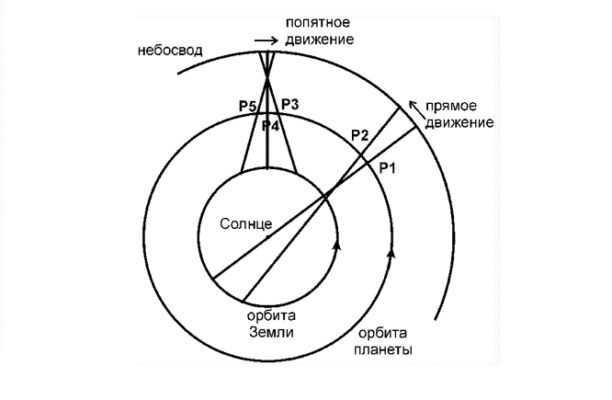
In the same edition, distances between the Sun and the planets, as well as the time it takes for them to complete an orbit, were calculated by Copernicus.
Copernicus did not claim the heliocentric system to be true in his work. He simply observed that this system greatly simplified calculations. However, the introduction of the heliocentric system provided a significant boost to the advancement of astronomical knowledge.
I. Kepler further developed and substantiated the Copernican heliocentric system in the early 17th century. Kepler’s laws not only clarified the paths of the planets by describing them as ellipses rather than circles but also enabled the calculation of velocities at any point on the ellipse.
What did we discover?
We have discovered that the sun, moon, and stars have a circular movement on the celestial sphere, with their centers located on the imaginary axis of the world. Additionally, we have learned that the planets move in loop-shaped paths. The understanding of this looping motion of the planets was only made possible with the acceptance of the heliocentric model of the world.


Currently, 58,741 educational institutions have access to exclusive cumulative discounts ranging from 2% to 25%. To determine the specific discount applicable to all staff members at your educational institution, simply login to your personal Infoworks account.


Professional development course
Peculiarities of preparing for conducting the All-Russian Comprehensive Assessment within the framework of monitoring the quality of education of students in the subject “Geography” in the conditions of implementing the Federal State Educational Standards of LLC
In addition to this discount, you can take advantage of the discount offered by your educational institution (which depends on the number of your colleagues who have completed Infoworks courses).
Currently, 58,741 educational institutions are eligible for additional discounts ranging from 2% to 25%. To find out the specific discount that applies to all employees of your educational institution, please log in to your personal Infoworks account.


Enroll in our professional development course today!
Preparing for the geography section of the USE under the FSES LLC
By taking advantage of this offer, your educational institution can receive an additional discount based on the number of colleagues who have already completed Infoworks courses.
Currently, 58,741 educational institutions are benefiting from our accumulative discount program, which offers discounts ranging from 2% to 25%. To learn more about the discount available to all employees at your educational institution, simply log in to your personal Infoworks account.


The significance of innovation and its role in educational practice
Discover resources for any lesson by selecting your subject (category), grade level, textbook, and topic:
There are 6,330,771 materials available in the database
The content is appropriate for UMK
Additional resources
- Book: “Geography (ed. “DROFA”)”, Dronov V.P., Barinova I.I. and others / Edited by Dronov V.P.
- Chapter: § 7. Phases and methods of geographical study of the territory.
- Book: “Geography. Geography”, Dronov V.P., Savelieva L.E.
- Chapter: § 7. Earth – a part of the Solar System
- Book: “Technology. Housekeeping Technology (ed. VENTANA-GRAF)”, Sinitsa N.V., Simonenko V.D.
- Subject: Cooking
These courses might catch your interest:
- Advanced Training Course in “Foundations of Tourism and Hospitality”
- Professional Development Course on “History and Philosophy of Science in the Implementation of FSES HE”
- Professional Retraining Course in “Management Organization in Tourism”
- Professional Development Course in “Insurance and Actuarial Calculations”
- Professional Retraining Course on “Developing an Effective Strategy for Modern University Development”
- Advanced Training Course in “World Economy and International Economic Relations”
- Advanced Training Course on “Current Issues in Banking Activity”
- Retraining course on “Managing museum objects and collections in all types of museums”.
- Retraining course on “Managing the activities of a property appraiser-expert”.
- Retraining course on “Teaching civil law disciplines: theory and methodology in educational institutions”.
- Retraining course on “Standardization and Metrology”.
- Retraining course on “Strategic management of remote information and reference services”.
- 05.06.2020 5151
- DOCX 15.7 kbytes
- 175 downloads
- Rating: 5 out of 5
- Rate the material:
If you think that the content infringes copyright or should be removed from the website for any other reason, you have the option to file a complaint regarding the material. Remove material
Author of the content
- Duration on the site: 5 years and 2 months
- Number of subscribers: 3
- Total views: 939397
- Total content: 246
Duration: 55 minutes
Duration: 46 minutes
Video lecture on the Characteristics of cognitive development in children with disabilities. Utilizing mnemonics in classes with children, including those with disabilities.
Duration: 41 minutes
Gift Vouchers
The users who have posted the materials on the site are responsible for resolving any disputes regarding the materials and their content. Nonetheless, the site administration is prepared to offer full assistance in resolving any matters pertaining to the site’s operations and content. If you come across any unauthorized use of materials on this site, kindly notify the site administration via the provided feedback form.

